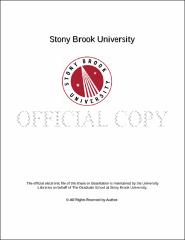| dc.identifier.uri | http://hdl.handle.net/11401/77539 | |
| dc.description.sponsorship | This work is sponsored by the Stony Brook University Graduate School in compliance with the requirements for completion of degree. | en_US |
| dc.format | Monograph | |
| dc.format.medium | Electronic Resource | en_US |
| dc.language.iso | en_US | |
| dc.publisher | The Graduate School, Stony Brook University: Stony Brook, NY. | |
| dc.type | Dissertation | |
| dcterms.abstract | Mention of the Holocaust brings to mind images of skeletal adults and piles of corpses. Less well-known is the experience of Jewish children who tried to survive the cataclysm in hiding, only a small fraction of whom succeeded. Roughly 90% of Europe’s prewar Jewish child population perished during the war. In Poland, the central location of concentration camps, historians estimate less than 1% survived, all of them assumed to have done so in hiding. In contrast to Anne Frank’s literal life behind the woodwork, in which for a time she was able to retain her Jewish identity, children who lived in open hiding had to forget the past, to mask themselves as faux Christians and never by a glance, an accent, or a social mistake reveal their original ethnic identity. Survival in this manner involved a combination of luck, planning, and the ability to live behind a wall of psychological silence. What is still missing from literary analysis on texts they produced is application of psychological theory developed specifically from therapeutic interaction with Jewish adults who began life as hidden children. Yvonne Tauber, a clinical psychologist at AMCHA, the National Israeli Center for Psychosocial Support for Holocaust Survivors and the Second Generation, coined the term “compound personality†to describe the coexistence of a shattered, traumatized child self and the chronologically appropriate adult self within the child survivor's personality. By-passing her theory in favor of dominant trauma theories makes critics miss important elements in child survivors’ memoirs and fiction. Indeed, when we apply the notion of compound personality to such texts, as is done in this dissertation, we discover a “literary thumbprint,†one that identifies these texts as a distinct sub-category of Holocaust literature. | |
| dcterms.available | 2017-09-20T16:52:53Z | |
| dcterms.contributor | Spector, Stephen | en_US |
| dcterms.contributor | Kaplan, Ann | en_US |
| dcterms.contributor | Hammond, Eugene | en_US |
| dcterms.contributor | Segal, Jeffrey. | en_US |
| dcterms.creator | Sofia, Carolyn M. | |
| dcterms.dateAccepted | 2017-09-20T16:52:53Z | |
| dcterms.dateSubmitted | 2017-09-20T16:52:53Z | |
| dcterms.description | Department of English. | en_US |
| dcterms.extent | 185 pg. | en_US |
| dcterms.format | Monograph | |
| dcterms.format | Application/PDF | en_US |
| dcterms.identifier | http://hdl.handle.net/11401/77539 | |
| dcterms.issued | 2015-05-01 | |
| dcterms.language | en_US | |
| dcterms.provenance | Made available in DSpace on 2017-09-20T16:52:53Z (GMT). No. of bitstreams: 1
Sofia_grad.sunysb_0771E_12681.pdf: 1697061 bytes, checksum: 96cff4c80f3a9641238bad812699f2d9 (MD5)
Previous issue date: 2015 | en |
| dcterms.publisher | The Graduate School, Stony Brook University: Stony Brook, NY. | |
| dcterms.subject | compound personality, Georges Perec, Hidden children, Holocaust, Jerzy Kosinski, Sarah Kofman | |
| dcterms.subject | Holocaust studies | |
| dcterms.title | Forgetting and Remembering: Narrating Holocaust Childhoods in Hiding | |
| dcterms.type | Dissertation | |

